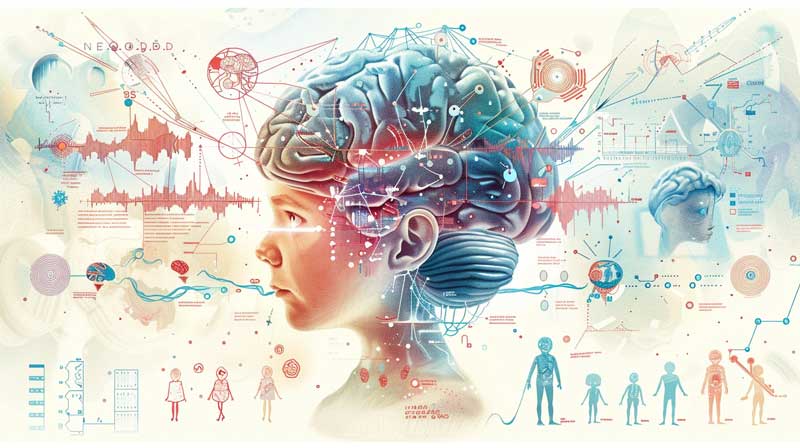Neocortex development in early life lays the foundation for a child’s future. This complex process, occurring primarily in the first few years, can either boost or limit a child’s potential. The intricacies of brain development are as complex as astrophysics, making them fascinating topics for parents and researchers.
Recent advances in technology and science are expanding our understanding of the brain. These findings reveal how neurons communicate, advancing neuroscience at a rapid pace.
I discovered this captivating subject while watching Joe Rogan’s podcast. The episode featured a discussion on Artificial Intelligence and the brain, introducing me to “A Thousand Brains: A New Theory of Intelligence” by Jeff Hawkins.
Hawkins, known for his work in mobile computing, shifted his focus to neuroscience. His aim was to explore intelligence and how the brain creates it. This ambitious undertaking has led to intriguing discoveries about intelligence in the brain.
As I read Hawkins’ theories, I was fascinated by his ideas on reference frames and brain models. The book explores natural and artificial intelligence, exploring AI’s potential contributions to our future and humanity.
What struck me most was the relevance of these concepts to parenting. The sections on early brain development resonated deeply, highlighting the crucial role of a child’s neocortex development in shaping future abilities.
In this post, I will explore how early experiences influence the neocortex, the science behind this critical period, and practical ways parents can support their child’s brain growth. We’ll also consider the long-term effects of early interventions and the balance between nurture and nature in child development.
Understanding the Neocortex: The Brain’s Learning Powerhouse
The neocortex, often called the ‘thinking brain,’ is fascinating. It’s the most recently evolved part of our brain, and this wrinkly outer layer makes up about 70% of its volume.
Hawkins’ book explains that the neocortex is where most intelligent functions happen. It’s responsible for vision, language, math, and engineering skills. When you think, it’s your neocortex at work.
What’s truly unique is how a child’s neocortex development unfolds. Unlike other brain parts, it’s not fully formed at birth. Instead, it grows and changes based on our experiences, especially early childhood.
This reminds me of my previous “A Child’s Calling: Signature Strengths” post. Just as we discovered that children have unique strengths, the neocortex develops differently for each child based on their experiences.
The neocortex is incredibly flexible in early life. It’s like a sponge, soaking up information and forming connections astoundingly. Scientists estimate the brain creates over a million synapses per minute in the first few years of life.
This rapid development is why early experiences are crucial. They literally shape the structure of a child’s brain. Realising how much impact our interactions have can be both exciting and daunting as a parent.
Exposing children to diverse experiences is essential for optimal child’s neocortex development. Giving their brain-rich input helps them develop fully. This understanding of the neocortex highlights the significance of varied early childhood experiences in shaping cognitive abilities.

The Science Behind Child’s Neocortex Development
The science of a child’s neocortex development is fascinating. Let’s break it down into key points:
- Rapid Growth: The neocortex undergoes explosive growth in early childhood. The brain can create crazy amounts of synapses per minute.
- Experience-Dependent Development: Unlike older brain parts, the neocortex is shaped by experiences. Scientists call this development ‘experience-expectant’ and ‘experience-dependent’.
- Critical Periods: Certain skills have ‘critical periods’ for optimal development. Language acquisition, for instance, is most accessible before puberty.
- Pruning Process: The brain goes through a ‘pruning’ process after rapid growth. Connections that aren’t used often are removed, streamlining the brain’s efficiency.
- Plasticity: The neocortex remains somewhat plastic throughout life. However, the most significant plasticity occurs in early childhood.
- Impact of Environment: A child’s environment is crucial to neocortex development. Studies on Romanian orphans showed how early deprivation affects brain structure.
The science behind a child’s neocortex development helps us appreciate why early experiences are crucial for learning facts and shaping the brain’s structure.
As a parent, this is both exciting and daunting. Every interaction and every experience we provide contributes to our children’s brain development. It’s a powerful reminder of the importance of nurturing environments in early childhood.

Why the First Few Years Are Critical for Brain Wiring
The first few years of a child’s life are crucial for neocortex development. During this time, the brain is most plastic and forms connections astoundingly.
What makes this period so unique? Here’s what I’ve learned:
- Rapid synapse formation: In early childhood, the brain creates synapses faster than at any other time. This forms the foundation for future learning.
- Experience-dependent plasticity: Children’s experiences directly shape their neural connections, which is why varied, stimulating environments are essential.
- Critical periods: Certain skills, like language, have specific windows for optimal development. Missing these can make later learning more challenging.
- Pruning process: After the initial growth spurt, the brain starts pruning unused connections, making the remaining connections more efficient.
Understanding the child’s neocortex development has changed how we view early childhood. We now ensure that we provide experiences that wire the brain for future learning.
Reflecting on these new insights, I noticed with my own children how quickly they pick up new skills in their early years. Their brains seem primed for learning, whether language, motor skills, or social interactions.
This critical period means learning continues after early childhood. But it does highlight why giving children a strong start is so important. It’s like building a house – a solid foundation makes future additions easier.
Practical Implications for Parents: Nurturing Your Child’s Neocortex
Understanding a child’s neocortex development has changed how I approach parenting. It’s not just about IQ scores anymore; we all have different natural abilities, as outlined in my post “A Child’s Calling: Multiple Intelligences, not Intelligence Quotient (IQ)“.
Here are some practical ways to nurture your child’s neocortex:
- Diverse experiences: Expose your child to a range of activities. This helps develop different areas of the neocortex.
- Language-rich environment: Talk to your child often and use varied vocabulary. This supports language centres in the neocortex.
- Physical activity: Encourage movement and play. It’s not just good for muscles—it also boosts brain development.
- Music and art: These activities stimulate creativity and cognitive skills.
- Emotional support: A nurturing environment helps the neocortex develop healthily.
- Limit screen time: Too much screen time may hinder neocortex development. Balance is key.
Remember, every child’s neocortex develops uniquely. What works for one might not work for another. It’s about finding what engages your child.
Focusing on my children’s strengths rather than pushing for high IQ scores increases enjoyment and learning. This approach aligns with the science of neocortex development.
By providing a stimulating environment, we’re teaching more than just skills. We’re helping shape the very structure of our children’s brains. It’s a big responsibility but also an exciting opportunity.

From Theory to Practice: Applying ‘A Thousand Brains’ to Child’s Neocortex Development
As a father of three since 2012, I’ve always been keen to support my children’s development. Reading “A Thousand Brains” has deepened my understanding of a child’s neocortex development, offering insights I wish I’d known earlier.
Scientists have long tried to unravel the brain’s mysteries. It’s remarkable how our brain allows us to think, act, and make sense of our environment seamlessly. Neuroscientists have discovered that, unlike species in Darwin’s evolution, the brain evolves by adding new parts to older structures.
This concept of brain evolution fascinates me. It explains why a child’s neocortex development is crucial in the early years. As we age, our brains become more fixed, making it harder to learn new concepts. If I remember correctly, this ‘fixing’ process peaks between 16 to 18 years old.
Applying ‘A Thousand Brains’ theory to parenting:
- Embrace diverse experiences: This helps form varied neural connections.
- Encourage curiosity: It fuels the brain’s natural learning processes.
- Provide a language-rich environment: It aids in cognitive development.
- Foster emotional intelligence: It’s as important as academic skills.
- Allow for unstructured play: It promotes creative problem-solving.
This approach to a child’s neocortex development explains why there’s so much emphasis on early childhood experiences. It’s about academic skills and shaping the brain’s very structure.
This knowledge offers me a sanctuary of understanding I never fully grasped before. This is not science fiction – it’s the reality of how our children’s brains develop and adapt.
By applying or trying to implement these insights, you are actively shaping your child’s neural architecture. This is a profound responsibility and an incredible opportunity to nurture your child’s potential.
Sources
- Bourgeois JP. Synaptogenesis, heterochrony and epigenesis in the mammalian neocortex. Acta Paediatrica Suppl. 1999;422:27-33.
- Greenough WT, Black JE, Wallace CS. Experience and brain development. Child Dev. 1987;58(3):539-559.
- Hawkins J. A Thousand Brains: A New Theory of Intelligence. Basic Books; 2021.
- Hensch TK. Critical period plasticity in local cortical circuits. Nat Rev Neurosci. 2005;6(11):877-888.
- Huttenlocher PR, Dabholkar AS. Regional differences in synaptogenesis in the human cerebral cortex. J Comp Neurol. 1997;387(2):167-178.
- Johnson JS, Newport EL. Critical period effects in second language learning: the influence of the maturational state on acquiring English as a second language. Cogn Psychol. 1989 Jan;21(1):60-99.
- Knudsen EI. Sensitive periods in the development of the brain and behaviour. J Cogn Neurosci. 2004;16(8):1412-1425.
- Nelson CA, Fox NA, Zeanah CH. Romania’s Abandoned Children: The Effects of Early Profound Psychosocial Deprivation on the Course of Human Development. Curr Dir Psychol Sci. 2023 Dec;32(6):515-521.
- Petanjek Z, Judaš M, Šimic G, et al. Extraordinary neoteny of synaptic spines in the human prefrontal cortex. Proc Natl Acad Sci U S A. 2011;108(32):13281-13286.


